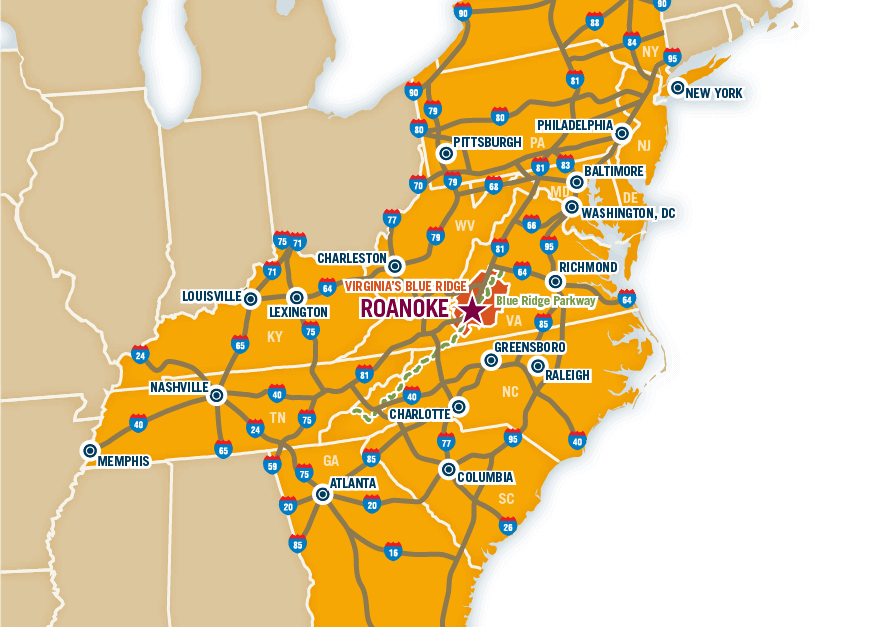-
Things To Do
- Arts & Culture
- Attractions
- Beer, Wine & Spirits
- Blue Ridge Parkway
- Events
- Free Things To Do
- History & Heritage
- Kid Friendly
- Nightlife
-
Outdoor Adventure
- Leave No Trace
- Trail Guidelines
- Appalachian Trail
- Biking
- Climbing
- Disc Golf
- Fall Color Spots
- Fishing
- Geocaching
- George Washington & Jefferson National Forests
- Greenways
- Hiking Trails
- Horseback Riding
- Kayaking & Paddling
- Kid Friendly Outdoors
- Motorcycle Touring
- Outdoor Outfitters & Shops
- Scenic Drives
- Water Sports
- Wildlife Viewing & Birding
- Classes & Workshops
- Sample Itinerary
- Sample Itineraries
- Shopping
- Spas
- Sports
- Tours
- VBR Savings Pass
- Hotels/Lodging
- Restaurants
- Region
- Plan
Blue Ridge Mountains History
The Roanoke Valley in Virginia's Blue Ridge began to form when settlers began to ride into the frontier behind the Blue Ridge Mountains.
These settlers established roots in the region by building homes and claiming farmland in the Roanoke Valley and neighboring Botetourt and Franklin counties in the mid 1700s.
The first newcomers, Germans and Irish, traveled on the Great Road through the Shenandoah Valley from Pennsylvania. The English came from Eastern Virginia into Franklin County.
Botetourt, dating from 1770, is the oldest county in Virginia's Blue Ridge. In the beginning, Botetourt's vast boundaries extended to the Mississippi River, covering Kentucky and parts of West Virginia, Indiana, Ohio and Illinois. Frontier residents lived so far from the Botetourt County seat in Fincastle that they were exempt from paying taxes.
Roanoke County was created from a portion of Botetourt much later in 1838. Franklin County was settled in 1786 by English in the east and Germans in the mountainous west.
Pioneer leaders were Colonel William Preston of Botetourt, known as the watchdog of the frontier; Colonel William Fleming, a Tinker Creek surgeon, acting governor of 1781 and head of the local government commission; and Andrew Lewis of present-day Salem, militia commander at the Battle of Point Pleasant.
Militia Colonel George Washington, only 24 at the time, rode westward on an inspection of frontier forts in 1756 and stopped at Fort William in Botetourt before heading to the Catawba Valley to Fort Vause in Shawsville in Montgomery County.
He then traveled south to Fort Trial at present-day Martinsville before returning to spend the night at the home of Widow Evans, who lived at the foot of Mill Mountain along the Roanoke River.
Early structures still remaining in the region from the Colonial period and early 1800s include the Washington Iron Works, which stands behind a Rocky Mount Home. The Buena Vista building, which served the Roanoke parks, was constructed prior to the Civil War. And one of the oldest homes in Roanoke County is the Harshbarger House, which was built in 1797 by Samuel Harshbarger, who later left the region and settled in Indiana because of his opposition to slavery.
The community of Salem officially formed in 1802 and it is the home of Roanoke College, which was founded in 1842. In Roanoke County, Hollins University was founded in 1837 as the Roanoke Female Seminary.
Prior to becoming known as "Roanoke," the town was called "Big Lick." The name was derived from the salty marshes in the area and how they attracted animals. Farming was the major occupation in the region until the arrival of the railroad in 1852, which brought the beginnings of commerce and industry to Virginia's Blue Ridge.
The area became known as a railroad town and attracted residents from around the world who have helped build the region into the economic and cultural center it has become.
In This Section
Want the latest on Virginia’s Blue Ridge? Securely sign up for our FREE e-newsletter:
Visit Virginia's Blue Ridge 101 Shenandoah Avenue NE Roanoke, VA 24016 (540) 342-6025 (800) 635-5535
Visit Virginia’s Blue Ridge is committed to cultivating an atmosphere that welcomes and celebrates the unique backgrounds, abilities, passions, and perspectives of our vibrant community. As our region’s only destination marketing organization, we have a responsibility to showcase the best the Roanoke Region has to offer, and those assets and strengths come in varied forms. We embrace differences in race, religion, sexual orientation, gender, gender identity or expression, language, visible and invisible disabilities, and all the intersecting identities that make Virginians and visitors alike so unique. We believe our differences make us stronger– and better.







